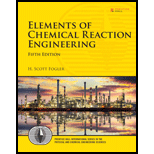
- (a) List the important concepts that you learned from this chapter. Make a list of concepts that you are not clear about and ask your instructor or colleague about them.
- (b) Explain the strategy to evaluate reactor design equations and how this chapter expands on Chapters 2 and 3.
(a)
Interpretation:
The important concepts that are learned by the mentioned chapter are to be stated. The concepts that are not clear to an individual are to be stated.
Concept Introduction:
The conversion, X can be defined as the moles of any species A that are reacted per mole of A fed in the reactor.
The full form of CSTR is Continuous-Stirred Tank Reactor. This reactor has its application in the industrial processes. This reactor is actually used for liquid-phase reactions.
The full form of PBR is Packed-Bed Reactor which is used for the fluid-solid heterogeneous reactions. These fluid-solid heterogeneous reactions take place at the surface of the catalyst.
Explanation of Solution
The first concept that is learned by the mentioned chapter is that the equation corresponding to the stoichiometric table for the reaction which takes place in the flow system is given as follows.
The expression that is used to calculate the concentration of reactants A and B corresponding to the incompressible liquids is given below.
Where,
The value
Where,
The value of
Thus, the above equation becomes as follows.
This reaction takes place in a batch system at constant volume.
The second concept that is learned by the mentioned chapter is the definition corresponding to the concentration for
The concentration of C is
Where,
The third concept that is learned by the mentioned chapter is about the concentration of different species till the
The concepts which are not clear are that how to express the reaction rate as the function of time and secondly the determination of the equilibrium conversion for batch reactor as well for flow reactors.
(b)
Interpretation:
The strategy to evaluate the design equations of the reactor is to be explained.
Concept introduction:
The sufficient energy that can be possessed by an effective collision is known as activation energy.
The full form of CSTR is Continuous-Stirred Tank Reactor. This reactor has its application in the industrial processes. This reactor is actually used for liquid-phase reactions.
Explanation of Solution
The strategy to evaluate the design equations of the reactor is the accumulation which expresses the in-out and generation consumption sum. The expression for the mass balance for this type of system is given below.
Where,
The value of
Where,
The value of
The expression for sum of the different terms is given below.
If
Substitute the value of
Thus, the above equation is the reactor design equation.
Want to see more full solutions like this?
Chapter 4 Solutions
Elements of Chemical Reaction Engineering (5th Edition) (Prentice Hall International Series in the Physical and Chemical Engineering Sciences)
Additional Engineering Textbook Solutions
Electric Circuits. (11th Edition)
Starting Out With Visual Basic (7th Edition)
Java: An Introduction to Problem Solving and Programming (8th Edition)
C++ How to Program (10th Edition)
Software Engineering (10th Edition)
Web Development and Design Foundations with HTML5 (8th Edition)
 Introduction to Chemical Engineering Thermodynami...Chemical EngineeringISBN:9781259696527Author:J.M. Smith Termodinamica en ingenieria quimica, Hendrick C Van Ness, Michael Abbott, Mark SwihartPublisher:McGraw-Hill Education
Introduction to Chemical Engineering Thermodynami...Chemical EngineeringISBN:9781259696527Author:J.M. Smith Termodinamica en ingenieria quimica, Hendrick C Van Ness, Michael Abbott, Mark SwihartPublisher:McGraw-Hill Education Elementary Principles of Chemical Processes, Bind...Chemical EngineeringISBN:9781118431221Author:Richard M. Felder, Ronald W. Rousseau, Lisa G. BullardPublisher:WILEY
Elementary Principles of Chemical Processes, Bind...Chemical EngineeringISBN:9781118431221Author:Richard M. Felder, Ronald W. Rousseau, Lisa G. BullardPublisher:WILEY Elements of Chemical Reaction Engineering (5th Ed...Chemical EngineeringISBN:9780133887518Author:H. Scott FoglerPublisher:Prentice Hall
Elements of Chemical Reaction Engineering (5th Ed...Chemical EngineeringISBN:9780133887518Author:H. Scott FoglerPublisher:Prentice Hall
 Industrial Plastics: Theory and ApplicationsChemical EngineeringISBN:9781285061238Author:Lokensgard, ErikPublisher:Delmar Cengage Learning
Industrial Plastics: Theory and ApplicationsChemical EngineeringISBN:9781285061238Author:Lokensgard, ErikPublisher:Delmar Cengage Learning Unit Operations of Chemical EngineeringChemical EngineeringISBN:9780072848236Author:Warren McCabe, Julian C. Smith, Peter HarriottPublisher:McGraw-Hill Companies, The
Unit Operations of Chemical EngineeringChemical EngineeringISBN:9780072848236Author:Warren McCabe, Julian C. Smith, Peter HarriottPublisher:McGraw-Hill Companies, The





